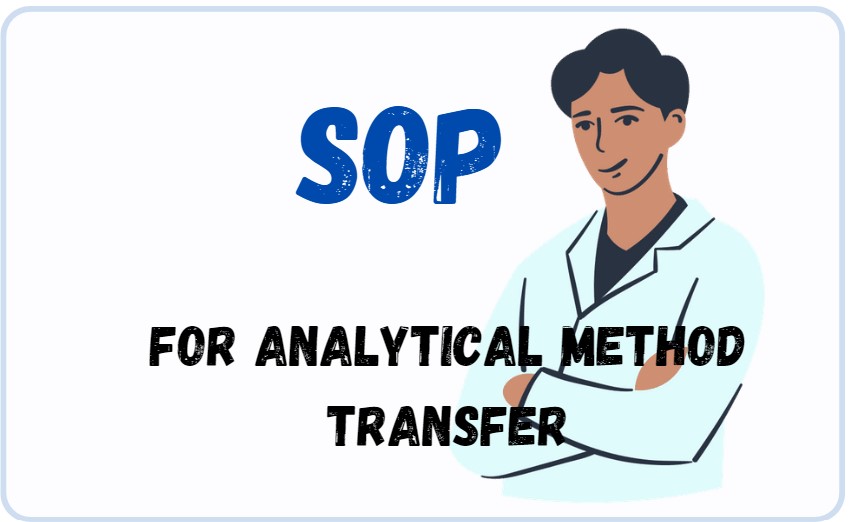SOP for Transferring Analytical Methods | Guidelines for Analytical Method Transfer | Acceptance Criteria for Analytical Method Transfer | Template for Analytical Method Transfer Protocol |

1.0 OBJECTIVE:
To establish a procedure for the successful transfer of analytical methods from the Analytical Development Laboratory or other sources (vendors) to the Quality Control (QC) laboratory, with predetermined acceptance criteria.
2.0 SCOPE:
This SOP applies to conducting the transfer of analytical methods for drug substances and drug products. It also covers discussions on all critical aspects of the analytical method.
3.0 RESPONSIBILITY :
- The Officer-ADL is responsible for Performing the analysis as per the protocol at both the sending and receiving units.
- The Officer-QC/Chemist-QC is responsible for Performing the analysis as per the protocol at the receiving unit.
- The Executive-ADL is responsible for Preparing the protocol, monitoring the entire analysis, and evaluating raw data.
- The Section head is responsible for Monitoring the entire analysis, discussing critical aspects of the analytical method with ADL, and final evaluation of raw data.
- The Manager-ADL is responsible for Reviewing the protocol and report.
- The Manager-QC is responsible for Reviewing the protocol and report. Ensuring compliance with the SOP.
- The Manager is responsible for Approving the protocol and report. Final acceptance of the method transfer.
4.0 ACCOUNTABILITY: Manager-QC
5.0 PROCEDURE for Analytical Method Transfer:
5.1 Responsibilities of the originating laboratory for the transfer of analytical methods:
- Preparation of the protocol.
- Providing method-specific training for analysts and quality control staff.
- Assisting in the analysis of quality control testing results.
- Defining all critical methods to be transferred for testing of the given product.
- Defining experimental design, sampling methods, and acceptance criteria.
- Providing any validation reports for methods under transfer and demonstrating their robustness.
- Providing details of the equipment used, if necessary, and any standard reference samples.
- Providing approved procedures used in the testing.
- Providing the working standards or reference standards, columns, and required chemicals.
- Reviewing and approving the transfer reports.
5.2 Responsibilities of the receiving Laboratory for the transfer of analytical methods:
- Reviewing the analytical method transfer protocol received from ADL.
- Reviewing the analytical methods provided by the originating laboratory and agreeing on acceptance criteria before executing the transfer protocol.
- Ensuring that the necessary equipment for quality control is available and qualified at the receiving Laboratory site. The equipment used by the receiving Laboratory during the analytical method transfer should meet appropriate specifications to ensure the method/specification requirements are met.
- Procuring the columns, standards, and chemicals as suggested by ADL.
- Ensuring that adequately trained and experienced personnel are in place for analytical testing.
- Generating and approving the transferred reports.
- Carrying out appropriate training on transferred methods and documenting all training activities and outcomes.
5.3 Preparation of protocol:
- The analytical method transfer protocol is normally prepared by the originating lab and should be reviewed by the Head of the originating lab and the Head of the receiving lab. The protocol should be approved by the Head of QA.
- The analytical method transfer protocol should describe the objective, scope, responsibilities of the originating laboratory and the receiving Laboratory. It should include specifications for materials and methods, experimental design, and acceptance criteria. Additionally, it should detail documentation requirements, deviations, references, approvals, and sample information (starting materials, intermediates, and finished products).
- If a customer’s protocol and acceptance criteria are available, the same method transfer procedure described above will be followed for the respective customer.
Read: SOP for Disintegration Test Apparatus
5.4 Procedure for method transfer:
- Analytical method transfer should be performed for Assay, Related substances, Dissolution, and Residual solvents for method precision and system precision.
- Any other tests that need to be performed shall be addressed in the method transfer protocol.
- Before transferring the analytical method, the method shall be validated by the originating laboratory.
- Once the method is validated, the originating laboratory shall send the method transfer protocol to the receiving Laboratory for approval along with the Standard Testing Procedure (STP).
- Ensure that the working standard, impurity standard, and test sample required for system suitability testing and method transfer experiments are in place before proceeding with the transfer activity.
- The method transfer protocol shall be approved by the QC and QA of the receiving lab, and the dates for its execution shall be communicated to the originating lab before the method transfer, to check and depute the analyst from the originating lab for the activity.
- After transferring the analytical method package, the receiving Laboratory shall approve the method transfer protocol and commence method transfer experiments as per the protocol.
- The analytical performance parameters required for individual analytical techniques include System suitability, Specificity, System precision, Method precision, etc.
- In case of any deficiencies in the method of analysis, the originating laboratory shall inform the receiving Laboratory. The receiving Laboratory shall review the completed analytical method transfer results and inform the originating laboratory accordingly.
5.5 If the acceptance criteria are not met, record it as a deviation in the protocol, and further action for continuing method transfer shall follow the recommendations provided by the originating laboratory:
- If the results do not meet the acceptance criteria, the method is not qualified for transfer.
- The receiving Laboratory should maintain records of the method transfer protocol, test results, and chromatograms of all experiments.
5.6 Experimental design:
- Testing and acceptance criteria should be based on the intended use of the method, in conjunction with data obtained during method validation and any historical data generated by the transferring laboratory.
- Acceptable method transfer may be demonstrated either by comparing data generated by the receiving laboratory with reference data from the transferring laboratory or by assuming equivalence of the two laboratories and demonstrating the validity of this assumption.
- Alternative procedures and acceptance criteria may be applied based on the characteristics of the analytical method.
5.7 Guideline for Acceptance Criteria:
- The provided acceptance criteria serve as a guide and may be adjusted on a case-by-case basis, provided that any deviation is justified and documented.
- Acceptance criteria for different tests, such as Main Component Assay, Preservative Assay, Dissolution, and others, are outlined based on specific criteria and requirements.
5.8 For all other tests, acceptance criteria shall be defined and agreed upon by both laboratories based on the nature of the methodology when approving the protocol.
5.9 Guidelines such as WHO, ICH, and any prevailing guidelines or regulations shall be followed for defining acceptance criteria.
- The numbering system for the protocol shall be as follows: PRO/MT/XXXX/YYY
5.10 The numbering system for the protocol shall be as follows:
- The first three characters represent ‘protocol.’
- The fourth character is a slash.
- The fifth and sixth characters represent ‘method transfer.’
- The seventh character is a slash.
- The eighth to eleventh characters are the first four letters of the product.
- The twelfth character is a slash.
- The thirteenth to fifteenth characters represent the serial number of the method transfer.
6.0 ABBREVIATIONS:
Abbreviation Expanded form
SOP Standard Operating Procedure
No. Number
Q.C. Quality Control
QA Quality Assurance
Dept Department
No. Number
ADL Analytical Development Laboratory
HPLC High-Performance Liquid Chromatography
GC Gas Chromatography
Related: SOP for Entry and Exit Procedure for visitors
